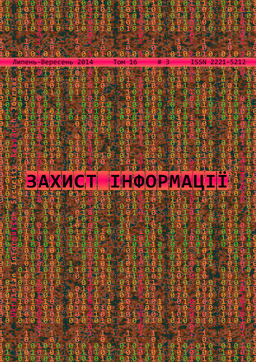Актуалізація інформації з обмеженим доступом у мережних ресурсах
DOI:
https://doi.org/10.18372/2410-7840.16.7536Ключові слова:
інформаційна безпека, мережні ресурси, захист даних, ІзОДАнотація
Для включення інформації з обмеженим доступом (ІзОД) до мережного інформаційного ресурсу (МІР), розміщеного у публічній, глобальній чи відкритій мережі іншого типу, необхідно вживати заходів з її додаткового захисту. Існуючі вимоги забороняють існування ІзОД у відкритих каналах зв’язку, проте не обмежують її існування у складі МІР –програмному коді, базах даних, тощо. У статті запропоновано схему взаємодії користувача з мережним інформаційним ресурсом для безпечної актуалізації ІзОД з відмовою від її існування у відкритому вигляді на усіх ланках схеми,окрім останньої. Запропоновано розділення автентифікаційних даних користувача на дві категорії, виділення трьох архітектурних шарів серверної частини та реалізацію контролю цілісності інформаційного обмінного процесу шляхом розподілу загального секрету за різними структурними елементами. Реалізація запропонованих заходів дозволитьпокращити інформаційну безпеку публічних МІР, особливо тих, що містять ІзОД.Посилання
. Про захист інформації в інформаційно-телекомунікаційних системах: Закон України вiд 05.07.1994 № 80/94-вр [Електронний ресурс]. – Режим доступу: http://zakon4.rada.gov.ua /laws /show/80/94-%D0%B2%D1%80
. Про доступ до публічної інформації: закон України вiд 13.01.2011 № 2939–VІ [Електронний ресурс]. – Режим доступу: http://zakon4.rada.gov.ua/laws / show/2939-17
. Про затвердження Правил забезпечення захисту інформації в інформаційних, телекомунікаційних та інформаційно-телекомунікаційних системах: Постанова Кабінету Міністрів України від 29.03.2006 № 373 [Електронний ресурс]. – Режим доступу: http://zakon2.rada.gov.ua / laws /show/373-2006-%D0%BF
. НД ТЗІ 2.5-010-2003 Вимоги до захисту інформації WEB - сторінки від несанкціонованого доступу. [Текст] / НД ТЗІ, затверджений наказом ДСТСЗІ СБ України від 02.04.2003 № 33.
. Громико І. Загальна парадигма захисту інформації: визначення термінів [Текст] / Ігор Громико // Правове, нормативне та метрологічне забезпечення системи захисту інформації в Україні, 2006. – вип. 2 (13). – с. 130-137.
. Василюк В. Об'єкти захисту інформації. методи та засоби захисту інформації [Текст] / Володимир Василюк // Правове, нормативне та метрологічне забезпечення системи захисту інформації в Україні, 2006. – вип. 2 (13). – с. 88-102.
. Тимченко Н. М. Правовий механізм доступу до публічної інформації: сучасний стан та перспективи [Електронний ресурс] / Н. М. Тимченко. – Режим доступу: http://lib.uabs.edu.ua/library /
P_Visnik/Numbers/1_6_2012/06_02_05.pdf
. Климентов В.В. Криптосистема с «виртуальным ключом» [Текст] / Климентов В.В., Трощило А.С. // Захист інформації, 2010. – №1 с. 89-94.
. Pei, D. Y. Authentication Schemes. [Електронний ресурс] / D. Y. Pei / Singapore: Institute for Mathematical Sciences. – 2001. – 36 p. Режим доступу: www2.ims.nus.edu.sg/ Programs/ coding/files/dypei.ps
. Самойленко Д. М. Комплексна система захисту інформаційного ресурсу Інформаційна безпека, 2013. – № 1 (9). с. 147-151 (ISSN 2224-9613)
. ISO/IEC 7498-2:1989(E) Information technology – Open Systems Interconnection – Basic Reference Model: Security Architecture. [Text] / International Organization for Standardization, 1989. First edition.
/ Switzerland: ISO/IEC Copyright Office. – 34 p.
##submission.downloads##
Опубліковано
Номер
Розділ
Ліцензія
Автори, які публікуються у цьому журналі, погоджуються з наступними умовами:- Автори залишають за собою право на авторство своєї роботи та передають журналу право першої публікації цієї роботи на умовах ліцензії Creative Commons Attribution License, котра дозволяє іншим особам вільно розповсюджувати опубліковану роботу з обов'язковим посиланням на авторів оригінальної роботи та першу публікацію роботи у цьому журналі.
- Автори мають право укладати самостійні додаткові угоди щодо неексклюзивного розповсюдження роботи у тому вигляді, в якому вона була опублікована цим журналом (наприклад, розміщувати роботу в електронному сховищі установи або публікувати у складі монографії), за умови збереження посилання на першу публікацію роботи у цьому журналі.
- Політика журналу дозволяє і заохочує розміщення авторами в мережі Інтернет (наприклад, у сховищах установ або на особистих веб-сайтах) рукопису роботи, як до подання цього рукопису до редакції, так і під час його редакційного опрацювання, оскільки це сприяє виникненню продуктивної наукової дискусії та позитивно позначається на оперативності та динаміці цитування опублікованої роботи (див. The Effect of Open Access).

